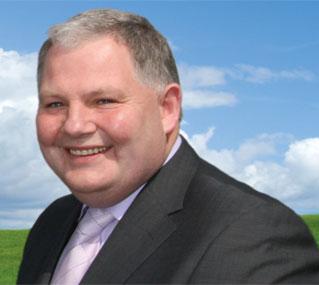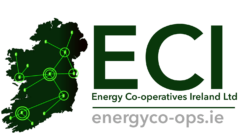 In his interview with Energy Co-operatives Ireland, Michael Hoey, of Country Crest, whose award winning commitment to sustainable energy in food production leads the way in the sector in North Dublin characterised his company’s success as a battle of perseverance against red tape and inertia.
In his interview with Energy Co-operatives Ireland, Michael Hoey, of Country Crest, whose award winning commitment to sustainable energy in food production leads the way in the sector in North Dublin characterised his company’s success as a battle of perseverance against red tape and inertia.
Country Crest employs over 200 people in its food growing, processing and distribution operation in North Dublin. It has led the way in demonstrating the commercial benefits of renewable energy to Irish business. “While the run up to Christmas is always our busiest time, we did not buy any electricity at all this December… we now average 70% of our energy requirement throughout the year.”
Country Crest’s plans for an Anaerobic Digester to compliment their very successful wind turbine are moving towards the planning stage. If their experience with the turbine is anything to go by this too could be a demonstration of the massive jobs, income and positive environmental potential of renewables.
Hoey is also enthusiastic about the ‘fantastic’ potential of the co-operative model for the renewables sector, recognising the synergy between local community ownership and sustainable, locally driven energy production. He himself is closely involved with the movement to re-instate the Irish Sugar industry which has food export, biomass electricity generation, and bio fuel production potential.
The key is the co-operative ownership structure: ‘where the people of Ireland are involved in the ownership which no multinational or anybody else can take it away from them’. He also said that the co-op model gives many people without a direct connection with the land but with an interest in the environment an input into renewable power generation. He did suggest however, that as with anyone trying to get involved in the energy sector inIreland, energy producer co-operatives have to persevere to achieve their plans, and have to find someone who can push through the red tape. They can then achieve job creation and revenue generation potential locally in the long term in an environmentally sustainable manner.
‘Ireland is like a racing yacht: it’s out in the Atlantic Ocean surrounded by a strong wind that should have it out in front of the competition winning the race in renewable energy technology…’
The potential for Irish businesses involved in energy intensive industries to cut their electricity bills, to make additional income from carbon offsets, to increase their jobs potential and to have a positive impact on their environment is demonstrated by Country Crest’s example. However, the take up of this potential is being limited by red tape:
‘Ireland is like a racing yacht: it’s out in the Atlantic Ocean surrounded by a strong wind that should have it out in front of the competition winning the race in renewable energy technology, but it’s being held back by red tape and people protecting their own patch: with the people, the skills and environment we have, we could be a real role model for other countries.’ There is an important role for government to ‘free up the bureaucracy and reduce the paperwork’.
However, he was quick to point out that this wasn’t evident in his own dealings with his local council, or the planners. Whereas elsewhere planning delays for essential elements of the new renewables infrastructure such as new power lines make this red tape situation worse, Fingal County Council has been very favourable to the company’s plans, with their recognition of their jobs potential (there’s over 140 people employed at Country Crest at the moment) overcoming any initial doubts. TheCountyManagerwas particularly helpful in the company’s dealings with the energy regulator and with Eirgrid.
The same cannot be said for other’s involved in the sector. Hoey pointed to the fact that the Chinese were years ahead of Ireland in green energy production where he felt we should be leading them, be their role model: ‘…the ESB and Eirgrid have a lot to answer for – the energy regulator must take responsibility.’
At the moment there’s a six to seven years lead in time from plans to electricity generation: ‘we’ve two feet on the brakes’.
Country Crest has received much well deserved praise for the way in which it has made a success of its food processing business bringing jobs and growth to North County Dublin. It’s recent Sustainability Award from Bord Bia has brought it plenty of positive recognition in the area of renewable power. However, Hoey is quick to point out that the success of its renewable energy strategy is a victory for perseverance as well as imagination.
The company started investigating the potential of the wind turbine in 2005 when they met Jan Olsen from Alpha Wind who carried out a wind survey of the site to determine it’s potential. He found it was ideal for wind generation. Back then, there was a job to be done convincing the local council of the suitability of the project to the area. The aviation authorities also had to be consulted as the site is near a flight path toDublinAirport. They had to produce animations and realisations of their plan to show its minimal impact on the environment. However, the council was receptive, and more importantly perhaps, so was the local community: there were no objections lodged to the planning application.
Much of the work on the project was driven by Country Crest’s Miriam Byrne, and Hoey strongly believes that renewables projects need to have someone behind them pushing them forward on a day to day basis: ‘Miriam stuck with it day after day, and kept persevering, going to meetings, dealing with the paperwork.’
This seems to be a feature of the sector; breaking through the red tape and overcoming obstacle after obstacle. It’s something that has to be borne in mind for anyone seeking to get into the green energy.
Country Crest’s wind turbine which received planning permission in 2008 had from the beginning the potential to export to the grid as well as knock up to €40,000 per month off the company’s energy bill. However, in a story familiar to many renewables producers inIreland, getting the grid connection was the issue. Country Crest found the ESB/Eirgrid very slow to assist in linking the turbine to the grid. As a result, while waiting for the grid connection to be set up (which the company itself had to pay for), the electricity generation potential of the turbine had to be limited by a software program until the connection was installed. Now that this connection, facilitated by Vayu which offers an alternative electricity and gas supply to Irish business, is up and running, the turbine generates much of the company’s electricity requirements with spare capacity in peak generation periods that Country Crest can export to the grid at a profit. It’s now achieved that impressive €40,000 potential. Despite the time, the expense, the planning, the turbine project now proves extremely cost beneficial.
The association of Country Crest with sustainability is also very significant to the business as a way of setting the company apart from competitor food producers. Initially, some of the larger companies were attracted to Country Crest because of its green initiatives, however, with many of these larger customers, price benefits are as important as the environmental benefits – a cost effective energy supply improves the food producer’s competitiveness. With many smaller customers and members of the public however, environmental concerns are still high, as indeed they are to Country Crest: ‘When you look at the damage that the last few generations have done to our environment we feel it’s now time that we took things in hand and we try and control what we are actually doing to our environment and our planet.’
According to Hoey, Country Crest’s new green energy initiative, the planned Anaerobic digester will be unlike the wind turbine in that it is more labour intensive and requires a lot of work in maintaining the right balance between the inputs and the microbes so that the power can be most efficiently produced. It’s going to be a bit more of a challenge, but he is confident that this new project will move ahead well and is hoping to get a refit by the end of April. Again Fingal County Council has been very helpful in pre-planning stages and seems to have learned from its positive experience of the wind project.
The Anaerobic Digester will take in 20 tonnes of biomass per day: meaning that the control of food waste will also be of great benefit. According to Hoey, countries throughout Europe and are taking food and brown bin waste from towns and cities and converting it into power. ‘There are over 4,000 of these units in Germany alone and as Chancellor Angela Merkel wants to lessen Germany’s dependence on nuclear fuel, anaerobic digestion will play a huge part in this. There are many farmers in Germany that are making a living out of generating power, they are also utilising the heat that is generated in towns, and villages.’
While every new technology has to overcome bureaucratic barriers, once up and running, there’s no end of enthusiasm and good will towards renewable generation. For Hoey, ‘there are lots of people sympathetic to the sector. There are lots of school groups and individuals who come up here to see the turbine: they love the idea that the wind blowing generates the energy that powers the fridge in their homes.’
